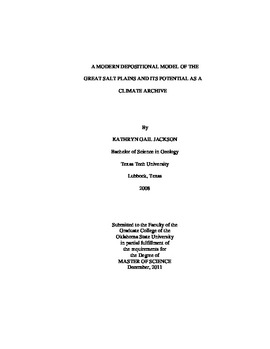| dc.contributor.advisor | Halihan, Todd | |
| dc.contributor.author | Jackson, Kathryn Gail | |
| dc.date.accessioned | 2014-03-14T21:51:57Z | |
| dc.date.available | 2014-03-14T21:51:57Z | |
| dc.date.issued | 2011-12-01 | |
| dc.identifier.uri | https://hdl.handle.net/11244/8026 | |
| dc.description.abstract | We investigate the potential of the Great Salt Plains (GSP) of northwestern Oklahoma for containing a climate archive by documenting the modern environments and creating a depositional model using trenches, cores, surface observations, aerial photographs, and GPS surveys. The GSP can be subdivided into five environments. These environments include sand flat, channel, mud/algal flat, delta and dunes. Each environment is marked by at least one distinct facies documented in trenches and surface observations. The most geographically widespread environment is the sand flat. Large expanses of sand flat are broken by many branching ephemeral channels of Spring, Clay, Powell Creeks and The Salt Fork of the Arkansas River. Cores and resistivity profiles were used to determine the vertical distribution of facies within the GSP. This subsurface data shows that although the sand flat environment is the most widespread environment today, the majority of the sedimentary deposits represent the channel environment with three (3) distinct sub-facies: sub-facies 1: tan-light brown to orange, coarse - granule sands with minor amounts of clay drapes, rip up clasts and cross bedding; sub-facies 2: brown-dark brown to black, fine - mud sized grains with plant fragments, trough cross bedding and inter-laminated sands and muds; and sub-facies 3: tan, to grey and rusty yellow, medium - coarse sands with flaser bedding, minor starved ripples and woody fragments. The avulsive nature of the Spring, Clay, Powell Creeks and The Salt Fork of the Arkansas River probably continuously reworks the sand flat facies making the preservation of a long continuous record of fine-grained sediments necessary for paleo-climate archive unlikely. Thus it is doubtful that the GSP contains a continuous long-term record of Holocene climate. | |
| dc.format | application/pdf | |
| dc.language | en_US | |
| dc.publisher | Oklahoma State University | |
| dc.rights | Copyright is held by the author who has granted the Oklahoma State University Library the non-exclusive right to share this material in its institutional repository. Contact Digital Library Services at lib-dls@okstate.edu or 405-744-9161 for the permission policy on the use, reproduction or distribution of this material. | |
| dc.title | Modern Depositional Model of the Great Salt Plains and Its Potential as a Climate Archive | |
| dc.type | text | |
| dc.contributor.committeeMember | Simms, Alexander R. | |
| dc.contributor.committeeMember | Cruse, Anna M. | |
| osu.filename | Jackson_okstate_0664M_11852.pdf | |
| osu.college | Arts and Sciences | |
| osu.accesstype | Open Access | |
| dc.description.department | Boone Pickens School of Geology | |
| dc.type.genre | Thesis | |
| dc.subject.keywords | continental-sabkha | |
| dc.subject.keywords | evaporite | |
| dc.subject.keywords | fluvial | |
| dc.subject.keywords | quaternary | |
| dc.subject.keywords | sedimentology | |
